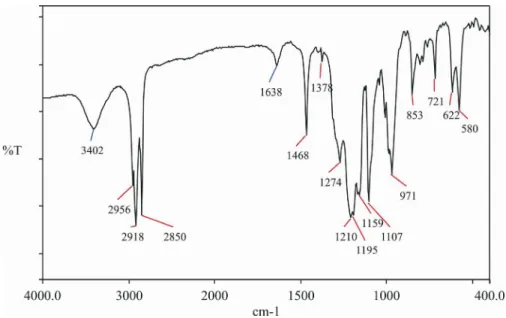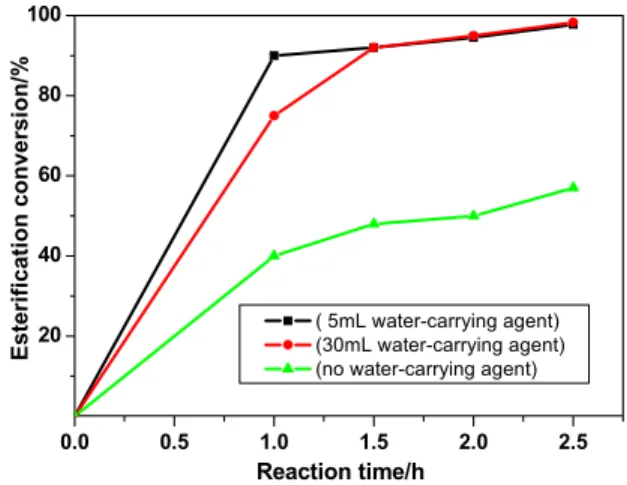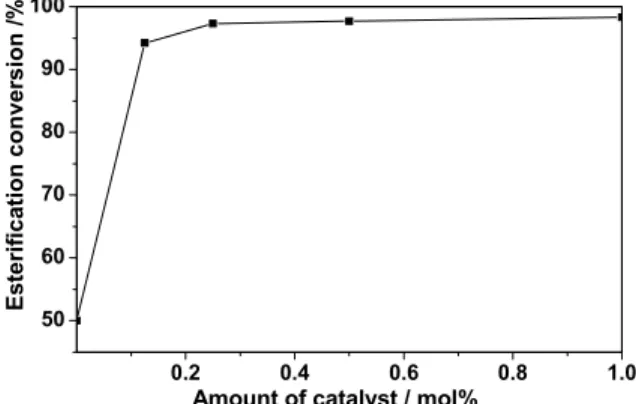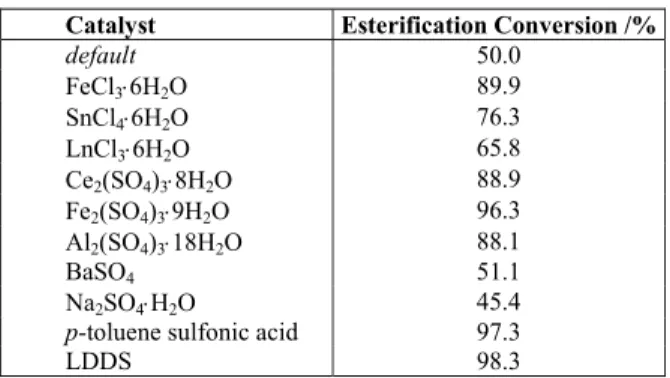ISSN 0104-6632 Printed in Brazil
www.abeq.org.br/bjche
Vol. 28, No. 02, pp. 259 - 264, April - June, 2011
*To whom correspondence should be addressed
Brazilian Journal
of Chemical
Engineering
ESTERIFICATION PROCESS TO SYNTHESIZE
ISOPROPYL CHLOROACETATE CATALYZED BY
LANTHANUM DODECYL SULFATE
Jiasheng Xu
1,2*, Jie Zhang
1, Xiangyu Yin
1, Dongjiang Yang
3, He Zhang
1,
Jianhua Qian
1, Lianli Liu
1and Xiaoyang Liu
21
Liaoning Province Key Laboratory for Synthesis and Application of Functional Compounds, College of Chemistry, Chemical Engineering and Food Safety, Center of Science and Technology
Experiment, Liaoning Province Research Center for Silicon Materials Engineering Technology, Phone/Fax: +86-416-3400240, Bohai University, 19 Sci-tech Road, Jinzhou 121013, P.R. China.
E-mail: jiashengxu@bhu.edu.cn
2State Key Laboratory of Inorganic Synthesis and Preparative Chemistry,
College of Chemistry, Jilin University, Changchun 130012, P.R. China.
3
Environmental Futures Centre and Griffith School of Environment, Gold Coast Campus, Griffith University, QLD 4222, Australia.
(Submitted: December 14, 2010 ; Revised: January 19, 2011 ; Accepted: January 19, 2011)
Abstract - Isopropyl chloroacetate has been synthesized by esterification of chloroacetic acid and isopropanol, using lanthanum dodecyl sulfate (LDDS) as the catalyst. Various factors that affected the esterification have been investigated, such as reaction time, different water-carrying agent and the amount of catalyst. Under the condition of 1.2/1 molar ratio of isopropanol to chloroacetic acid, 1.0% catalyst (molar percent of chloroacetic acid), 2.5 h reaction time, 5 mL cyclohexane as water-carrying agent and reflux temperature, the esterification conversion of isopropyl chloroacetate reaches 98.3%. The catalytic activity of LDDS is almost equal to that of a Brønsted acid. LDDS, as one kind of water-tolerant Lewis acid, is an excellent catalyst compared to the traditional Lewis acid.
Keywords: Isopropyl chloroacetate; Lanthanum dodecyl sulfate; Esterification; Water-tolerant Lewis acid; FTIR.
INTRODUCTION
As one of the most fundamental and important reactions in organic synthesis and chemical engineering, esterification has attracted considerable attention in recent years (Nicolaou et al, 2000; Xu and Xue, 2006). The most common method for preparing esters is to heat a carboxylic acid (R-COOH) with an alcohol (R'-OH) while removing the water that is formed. The reaction is slow and reversible. An acid catalyst is usually needed to make the reaction occur at a useful rate. It has been reported that many acid catalysts used in the esterification reaction affect the reaction rate (Qiao et al., 2006; Cai et al., 2007).
Many useful and reliable water-tolerant catalysts have been reported for organic synthesis in the literature, such as Cu(OTf)2, Ln(OTf)3, and Sc(OSO3C12H25)3. However, these catalysts are very expensive and the synthetic methods are complicated (Wang et al., 2005). In this paper, it has been found that lanthanum dodecyl sulfate (LDDS) exhibits high catalytic activity for esterification during the synthesis of isopropyl chloroacetate. This catalytic method is environmentally benign, with high esterification conversion, which may provide new opportunities for new green chemistry synthesis.
EXPERIMENTAL
Materials and Instrument
All chemicals were analytical reagents (A.R.), and were purchased from Beihua Fine Chemical Co., Beijing, and were employed without further purification. FTIR spectra were recorded on a Fourier transmission infrared spectrometer (FTIR, NEXUS) in KBr discs. Sixteen scans were co-added with a resolution of 4 cm−1, OPD was 0.2 cm·s–1, in the wavenumber range of 400–4000 cm−1.
Preparation of Lanthanum Dodecyl Sulfate (LDDS)
Lanthanum dodecyl sulfate is prepared through the reaction between LaCl3·6H2O and C12H25OSO3Na. The procedure is shown below:
LaCl3·6H2O (10.6 g) was dissolved in a flask (100 mL water) on a magnetic stirrer. C12H25OSO3Na (25.2 g) was dissolved in a flask (700 mL water). While stirring vigorously (rotation speed more than 1000 r/min), the solution of LaCl3·6H2O was added slowly to the solution of C12H25OSO3Na. The mixture was stirred at room temperature for 30 minutes, until no more white precipitate formed. The white precipitate was filtrated off and then the resulting solid was washed twice with deionized water. The resulting LDDS was then dried at 50°C for more than 5 h in a vacuum drying oven to remove the remaining water. The weight of the as-prepared lanthanum dodecyl sulfate was 26.7 g; the conversion was 95.2%.
The FTIR spectrum of LDDS is shown in Figure 1. It can be seen that these spectra coincide well with these reported in the literature (Qian et al., 2011). The bands of methyl and methylene in LDDS are very strong:
3
as CH
ν
(2956 cm-1), 3s CH
ν
(2850 cm-1),as CH 2
ν
(2918 cm-1), 2as
CH
δ
(1468 cm-1), ρCH2 (721 cm-1 ),
3
s
CH
δ
(1378 cm-1). The bands of S=O, O=S=O, and C-O-S can be clearly seen:δ
S O= (1210 cm-1),s O S O= =
ν
(1159 cm-1),ν
S O= (1107 cm-1),ν
C S O− − (971 cm-1),ν
asO S O− − andν
S Os− (853 cm-1),ν
sS O− (622 cm-1),ν
asO S O= = (580 cm-1).
Brazilian Journal of Chemical Engineering Vol. 28, No. 02, pp. 259 - 264, April - June, 2011 Esterification Procedures
A typical experimental procedure for the esterification of chloroacetic acid with isopropanol is described as follows: chloroacetic acid 15.8 g (166.7 mmol), isopropanol and catalyst were added to a 100 mL conical flask. The flask was equipped with a magnetic heating stirrer and a condenser with a water separator (saturated NaCl solution was added). The mixture was refluxed for 0.5–2.5 h. The mixture was cooled down to room temperature and the catalyst was separated by decantation. The organic phase was analyzed by gas chromatography (GC). The results show that no side reaction occurred. The esterification conversion was calculated as follows:
Esterification conversion (%) acid number of the beginning acid number of the end
100 acid number of the beginning
= −
×
where the acid number is measured by titration with standard KOH solution according to the method of GB/T 1668-2008. It was demonstrated that the deviation between GC and titration methods is less than 1.0 %.
RESULTS AND DISCUSSION
Effect of Different Kinds of Water-Carrying Agents on the Esterification Conversion
Generally, esterification reactions are slow and reversible. It is also well known that the water-carrying agents can favor this reaction in a positive direction during the reaction process. The esterification experiments were carried out with the condition of 1.2/1 molar ratio of isopropanol to chloroacetic acid, 1.0% catalyst (molar percent of chloroacetic acid), 2.5 h reaction time, reflux temperature, and 5 mL of different water-carrying agents. At the beginning of the reaction, the reaction mixture is ahomogeneous solution. Since the LDDS is dissolved in this reaction medium, the water-carrying agents are helpful for the solution of LDDS. The reaction is homogeneously catalyzed and the esterification conversion increases with the reaction time in the initial stage. As shown in Figure 2, the reaction time is prolonged to 2.5 h, which is enough for this reaction (see Figure 2). The detailed experimental results are shown in Table 1. It should be noted that the esterification conversion is much
higher than that in the absence of water-carrying agents. The esterification conversion of the default experiment is 63.8%; the conversion was 98.3% when cyclohexane was used as water-carrying agent. The esterification conversion is optimal in the presence of cyclohexane, among the three water-carrying agents (benzene, toluene, and cyclohexane). Therefore, cyclohexane was chosen as water-carrying agent in this reaction process.
0.0 0.5 1.0 1.5 2.0 2.5
20 40 60 80 100
Es
te
rifica
tion c
onv
ers
ion
/%
Reaction time/h
( 5mL water-carrying agent) (30mL water-carrying agent) (no water-carrying agent)
Figure 2: Effect of reaction time and quantity of water-carrying agent on the esterification conversion.
Table 1: Effect of different water-carrying agents on the esterification conversion.
Water-carrying
agent default Benzene Toluene Cyclohexane Esterification
Conversion/% 63.8 97.8 93.1 98.3
Effect of Amount of Water-Carrying Agent and Reaction Time on the Esterification Conversion
concentration of the reactant decrease, which will decelerate the esterification conversion. At the same time, the reaction temperature can increase quickly at the beginning of this reaction, thus making the reaction take place more quickly. Therefore, the esterification conversion is higher than when cyclohexane is fixed at 30 mL and the reaction time is 1 h. When the reaction time is more than 1 h, both of the esterification conversions reached the same level (Figure 2). The reason is that LDDS has high esterification catalytic activity. Given that more cyclohexane can introduce more byproducts, 5 mL cyclohexane was chosen as the water-carrying agent in this esterification process.
Effect of Amount of Catalyst on the Esterification Conversion
The esterification experiments were carried out under the condition of 1.2/1 molar ratio of isopropanol to chloroacetic acid, 2.5 h reaction time, 5 mL cyclohexane as water-carrying agent and at reflux temperature. The amount of catalyst, such as 0.25%, 0.5%, and 1.0% (molar percent of chloroacetic acid) are considered. Figure 3 shows the effect of the amount of catalyst on the esterification
conversion. It can be clearly seen that the esterification conversion increased with the increase of the amount of catalyst. The esterification conversion is about 50% even when there is no catalyst in this reaction medium. This reaction process (the reaction conditions such as 1.2/1 molar ratio of isopropanol to chloroacetic acid, 2.5 h reaction time, 5 mL cyclohexane, and reflux temperature) provides a good reaction medium for the esterification of chloroacetic acid with isopropanol. The esterification conversion was 98.3% when the amount of catalyst was 1%.
After the reaction, the catalyst can be recycled. This method for the esterification of chloroacetic acid with isopropanol without any side reaction is more environmentally friendly and economical. It is important to investigate the reusability of LDDS as catalyst in the synthesis of isopropyl chloroacetate under the same reactive conditions. The LDDS is solubilized in the reaction medium and, after cooling, stays in the solid state. After reaction, LDDS can be filtered without any treatment for recycling. As shown in Figure 4, the catalytic activity of the recovered LDDS is decreased after the first round, but the esterification conversion still maintains 75% after 5 cycles.
0.2 0.4 0.6 0.8 1.0
50 60 70 80 90 100
Es
terif
ica
tion
con
v
e
rsion
/
%
Amount of catalyst / mol%
Figure 3: Effect of the amount of catalyst on the esterification conversion.
0 1 2 3 4 5 6
50 60 70 80 90 100
Este
rificat
ion
c
onve
rsion /%
Number of recyclings
Brazilian Journal of Chemical Engineering Vol. 28, No. 02, pp. 259 - 264, April - June, 2011 The Comparison of LDDS Catalytic Activity with
Other Catalysts
The catalytic activity of various catalysts is compared under the same reaction conditions (i.e., 1.2/1 molar ratio of isopropanol to chloroacetic acid, 1.0% catalyst 2.5 h reaction time, 5 mL cyclohexane as water-carrying agent and reflux temperature). The results are summarized in Table 2. Apparently,
p-toluene sulfonic acid is effective for esterification, but the protic acid is difficult to separate from the mixture solution after reaction. The catalytic activity of LDDS is higher than that of FeCl3⋅6H2O, SnCl4⋅6H2O, LnCl3⋅6H2O, Ce2(SO4)3⋅8H2O, Fe2(SO4)3⋅9H2O and other Lewis acids (Table 2). The neutral salts (BaSO4, Na2SO4⋅H2O) showed very little activity during this esterification process.
The esterification reaction is slow and reversible. At the same time, water will form during the esterification process. The existence of water will reduce the rate of the esterification. If the esterification catalyst is water-tolerant, the esterification conversion will increase drastically during the whole process. In this experimental process, LDDS, as a kind of water-tolerant Lewis acid, is superior to traditional Lewis acids in this esterification process.
Table 2: Comparison of different catalysts used for the esterification.
Catalyst Esterification Conversion /%
default 50.0
FeCl3⋅6H2O 89.9
SnCl4⋅6H2O 76.3
LnCl3⋅6H2O 65.8
Ce2(SO4)3⋅8H2O 88.9
Fe2(SO4)3⋅9H2O 96.3
Al2(SO4)3⋅18H2O 88.1
BaSO4 51.1
Na2SO4⋅H2O 45.4
p-toluene sulfonic acid 97.3
LDDS 98.3
CONCLUSION
In summary, a new catalytic esterification process for the synthesis of isopropyl chloroacetate has been successfully designed, using lanthanum dodecyl sulfate (LDDS) as the catalyst. It has been found that LDDS exhibits high catalytic activity for esterification during the synthesis of isopropyl chloroacetate. Under the condition of 1.2/1 molar ratio of isopropanol to chloroacetic acid, 1.0%
catalyst (molar percent of chloroacetic acid), 2.5 h reaction time, 5 mL cyclohexane as water-carrying agent and reflux temperature, the esterification conversion of isopropyl chloroacetate is 98.3%. LDDS, as a kind of water-tolerant Lewis acid, is a better catalyst compared with traditional Lewis acids in this esterification process. This catalytic method is environmentally benign, with high esterification conversion, which may meet the standards of green chemistry.
ACKNOWLEDGEMENTS
The authors gratefully acknowledge the financial support of the State Key Laboratory of Inorganic Synthesis and Preparative Chemistry (Jilin University) Open Research Fund (2011-29), Liaoning Province Excellent Talents Program in Universities (2009R02), the Building Program for Engineering Technology Research Center in Liaoning Province Science and Technology Agency (2009402007), and the Program for Innovative Research Team in Liaoning Province.
REFERENCES
Cai, Y., Huang, D., Wan, H., and Guan, G., Preparation of a silica gel confined ionic liquid and its use as catalyst for esterification. Fine Chemicals (Chinese), 24, p. 1196-1199 (2007). Fraga-Dubreuil, J., Bourahla, K., Rahmouni, M.,
Bazureau, J., and Hamelina, J., Catalysed esterifications in room temperature ionic liquids with acidic counteranion as recyclable reaction media. Catal. Commun., 3, p. 185-190 (2002). Kobayashi, S., and Ogawa, C., New entries to
water-compatible Lewis acids. Chem. Eur. J., 12, p. 5954-5960 (2006).
Nicolaou, K. C., Vourloumis, D., Winssinger, N., and Baran, P., The art and science of total synthesis at the dawn of the twenty-first century. Angew. Chem. Int. Ed.,39, p. 44-122 (2000). Palaniappan, S., and Ram, M., Esterification of
carboxylic acids with alcohols catalyzed by polyaniline salts. Green Chem., 4, p. 53-55 (2002).
Qiao, K., Hagiwara, H., and Yokoyama, C. Acidic ionic liquid modified silica gel as novel solid catalysts for esterification and nitration reactions. J. Mol. Catal. A: Chem.,246, p. 65-69 (2006). Qian, J., Xu, J., and Zhang, J., SDS-catalyzed
chloroacetate. Petrol. Sci. Technol., 29, p. 462-467(2011).
Wang, M., Wang, Z., Sun, Z., and Jiang, H., Reaction-controlled recovery of the copper (II) methanesulfonate catalyst for esterification. React. Kinet. Catal. Lett., 84, p. 223-228 (2005).
Xu, J., and Xue, D., Fabrication of copper hydroxyphosphate with complex architectures. J. Phys. Chem. B, 110, p.7750-7756 (2006). Yong, L., Xie, C., Yang, K., Yu, S., and Liu, F.,



